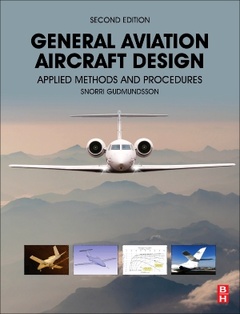General Aviation Aircraft Design (2nd Ed.) Applied Methods and Procedures
Auteur : Gudmundsson Snorri

General Aviation Aircraft Design, Second Edition, continues to be the engineer?s best source for answers to realistic aircraft design questions. The book has been expanded to provide design guidance for additional classes of aircraft, including seaplanes, biplanes, UAS, high-speed business jets, and electric airplanes. In addition to conventional powerplants, design guidance for battery systems, electric motors, and complete electric powertrains is offered. The second edition contains new chapters:
- Thrust Modeling for Gas Turbines
- Longitudinal Stability and Control
- Lateral and Directional Stability and Control
These new chapters offer multiple practical methods to simplify the estimation of stability derivatives and introduce hinge moments and basic control system design. Furthermore, all chapters have been reorganized and feature updated material with additional analysis methods. This edition also provides an introduction to design optimization using a wing optimization as an example for the beginner.
Written by an engineer with more than 25 years of design experience, professional engineers, aircraft designers, aerodynamicists, structural analysts, performance analysts, researchers, and aerospace engineering students will value the book as the classic go-to for aircraft design.
1. Aircraft design process 2. Aircraft cost analysis 3. Initial sizing 4. Aircraft conceptual layout 5. Aircraft structural layout 6. Aircraft weight analysis 7. Selecting the power plant 8. The anatomy of the airfoil 9. The anatomy of the wing 10. The anatomy of lift enhancement 11. The anatomy of the tail 12. The anatomy of the fuselage 13. The anatomy of the landing gear 14. Thrust modeling for gas turbines 15. Thrust modeling for propellers 16. Aircraft drag analysis 17. Performance – introduction 18. Performance – take-off 19. Performance – climb 20. Performance – cruise 21. Performance – range analysis 22. Performance – descent 23. Performance – landing 24. Longitudinal stability and control 25. Lat-dir stability and control 26. Miscellaneous design notes
Appendix A. Atmospheric modeling B. Aerospace engineer's formula sheet C. Design of biplanes and seaplanes D. Derivation of landing side-constraint
Dr. Snorri has a Youtube channel on Aircraft Design: https://www.youtube.com/channel/UCS0O5jdhFrdYBFC5YJP6axg/
- The printed book is now in color, with 1011 figures and illustrations!
- Presents the most common methods for conceptual aircraft design
- Clear presentation splits text into shaded regions, separating engineering topics from mathematical derivations and examples
- Design topics range from the "new" 14 CFR Part 23 to analysis of ducted fans. All chapters feature updated material with additional analysis methods. Many chapters have been reorganized for further help. Introduction to design optimization is provided using a wing optimization as an example for the beginner
- Three new chapters are offered, two of which focus on stability and control. These offer multiple practical methods to simplify the estimation of stability derivatives. The chapters introduce hinge moments and basic control system design
- Real-world examples using aircraft such as the Cirrus SR-22 and Learjet 45
Date de parution : 04-2022
Ouvrage de 1142 p.
21.5x27.6 cm
Thèmes de General Aviation Aircraft Design :
Mots-clés :
aircraft design; aircraft weight; power plant; airfoil; wing; lift enhancement; tail; fuselage; landing gear; tires; brakes; leading edge; trailing edge; piston engine; turboprop; turbofan; turbojet; inlet; electric motor; airframe; single engine; multi-engine; subsonic; supersonic; seaplane; sailplane; general aviation; airplane engines; take-off; climb; cruise; range; descent; landing; longitudinal stability; directional stability; lateral stability; dynamic stability; formula sheet; atmospheric modeling; drag modeling; thrust modeling; general aviation



